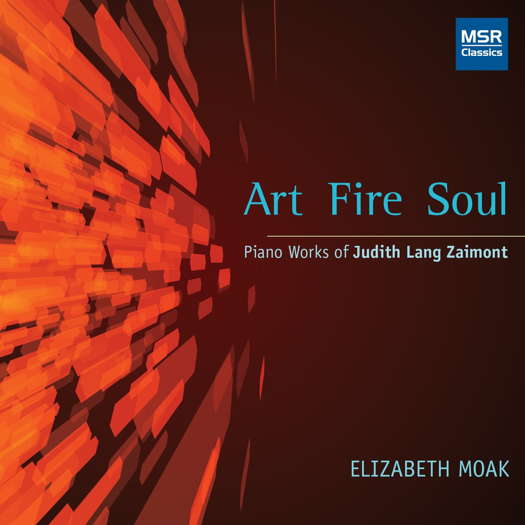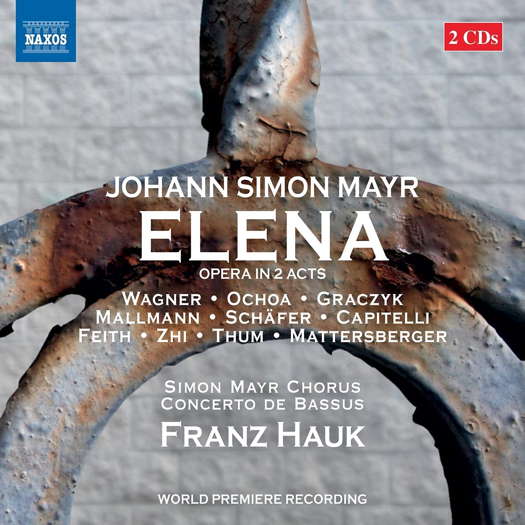- Terry Riley
- Peter Ilyich Tchaikovsky
- Guastavino
- Suffolk
- Sarah Caldwell
- William Carragan
- Modeste Mussorgsky
- Gaynor Keeble
 SPONSORED: CD Spotlight. An Encyclopedic Recital - Elizabeth Moak plays Judith Lang Zaimont, heard by the late Howard Smith.
SPONSORED: CD Spotlight. An Encyclopedic Recital - Elizabeth Moak plays Judith Lang Zaimont, heard by the late Howard Smith.
All sponsored features >>
ARTICLES BEING VIEWED NOW:
- Régine Crespin
- Hector Berlioz
- Ruth Railton
- Marián Varga
- Profile. A Very Positive Conductor - Paul Bodine talks to Los Angeles Opera's Music Director Designate, Domingo Hindoyan

Helen (without Troy)
GIUSEPPE PENNISI listens to Johann Simon Mayr's 'Elena'
'Even if I doubt that this Elena will ever be staged again, this CD is a good way to appreciate Mayr's strengths and weaknesses.'
Naxos is producing and recording a number of operas by Johann Simon Mayr (14 June 1763 – 2 December 1845), very popular in his own times and now mostly remembered solely as an early inspiration to Goacchino Rossini and Gaetano Donizetti.
As reported here on 23 September 2020, when I reviewed another of Mayr's operas, Le due Duchesse, Mayr was born in Mendorf near Altmannstein, Landkreis Eichstätt, Bavaria, and studied theology at the University of Ingolstadt, continuing his studies in Italy from 1787. He was closely associated with the Illuminati of Adam Weishaupt while a student in Ingolstadt, and the ideals of the French Enlightenment were a strong influence on his philosophy as a musician as corroborated by his famed Zibaldone or 'Notebooks' compiled toward the end of his career. He took music lessons with Carlo Lenzi, and later with Ferdinando Bertoni.
He moved to Bergamo in 1802 and was appointed maestro di cappella at the Cathedral of Bergamo, succeeding his old teacher Lenzi. He held the post until his death, and became a central figure in the city's musical life, organizing concerts and introducing Ludwig van Beethoven's music there. He was the music teacher of Gaetano Donizetti. By the end of his life, he was blind. He died in Bergamo and is buried in the Basilica di Santa Maria Maggiore there, just in front of the tomb of his famous pupil. Mayr's works, among which there are almost seventy operas, are rarely performed today.
I doubt that there will be a Mayr renaissance; maybe, associated with the Bergamo Annual Donizetti Festival, the revival of some of his operas is possible. His style is closely linked to the period when he lived and operated. He preferred 'semi-serious operas', a genre that disappeared in the early nineteenth century. The Naxos initiative to produce a number of first recordings of some of his best and most fortunate works deserves applause because it is a very good means to get to know Mayr as a composer, not only as a teacher.
The ensemble of Elena is pretty much the same of that of Le due Duchesse. Franz Hauk conducts Concerto de Bassus, an international ensemble engaging young musicians in historical performance of music from the seventeenth, eighteenth and nineteenth centuries. Many members of the ensemble are outstanding students or graduates of the Hochschule für Musik und Theater Munich, with wind instruments constructed on historical principles. This youthful enthusiasm can be felt as from the symphony.
Listen — Mayr: Sinfonia (Elena)
(8.660462-63 CD1 track 1, 0:00-0:52) ℗ 2021 Naxos Rights (Europe) Ltd :
The main singers - Sophie Wagner, Daniel Ochoa, Mira Graczyk, Niklas Mallmann and Markus Schäfer - and the Simon Mayr Chorus are young too and made their names in Baroque music.
The opera has nothing to do with Helen of Troy as one would think, also because Greek myths were a great coffer from which libretto writers found a source of inspiration. The work, also known as Elena e Costantino, is an 1814 opera semiseria to a libretto by Leone Tottola. It was premiered in Naples in 1814 and was later adjusted for La Scala in 1816 where Meyerbeer may have heard it using the same plot in Emma di Resburgo. Goethe and Zelter's correspondence makes mention of the sextet in Act II, as reported by Stendhal. It is a pièce à sauvetage, with dramatic and buffo parts.
The plot is very complicated and dramatically weak. In Naples the musical numbers were connected by spoken parts. In Milan, where there were forty performances, the spoken parts were transformed into recitative. This rendering follows the Milan version.
The musical numbers are mostly duets, trios, quartets and the already mentioned sextet that enthralled Naples and Milan audiences.
Listen — Mayr: Solo son ... o miei sospiri! (Elena)
(8.660462-63 CD2 track 14, 9:37-10:26) ℗ 2021 Naxos Rights (Europe) Ltd :
There are three quite remarkable arias; one by the buffo, one by the bass and one by the soprano.
Listen — Mayr: Ah! non partir! (Elena)
(8.660462-63 CD2 track 12, 0:00-0:40) ℗ 2021 Naxos Rights (Europe) Ltd :
However, the salient points are the ensembles, especially the finales of the two acts.
Listen — Mayr: Gnorsì ... nuje ve credimmo (Elena)
(8.660462-63 CD2 track 16, 1:21-1:58) ℗ 2021 Naxos Rights (Europe) Ltd :
The orchestration is good but not exceptional.
Even if I doubt that this Elena will ever be staged again, this CD is a good way to appreciate Mayr's strengths and weaknesses.
Copyright © 12 March 2022
Giuseppe Pennisi,
Rome, Italy

CD INFORMATION - JOHANN SIMON MAYR: ELENA
CLASSICAL MUSIC ARTICLES ABOUT GERMANY
CLASSICAL MUSIC ARTICLES ABOUT ITALY


